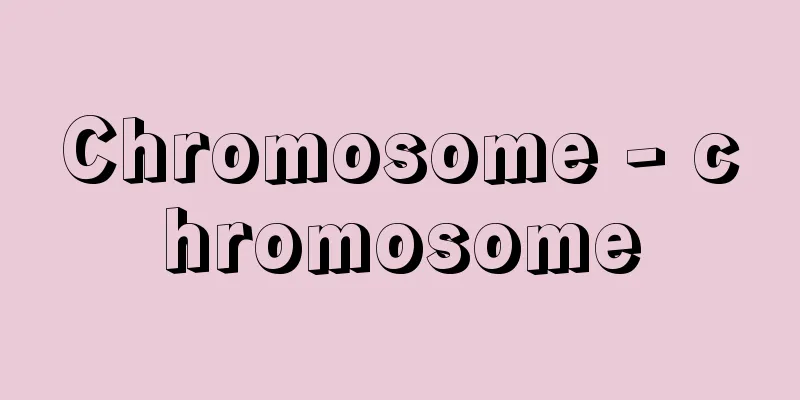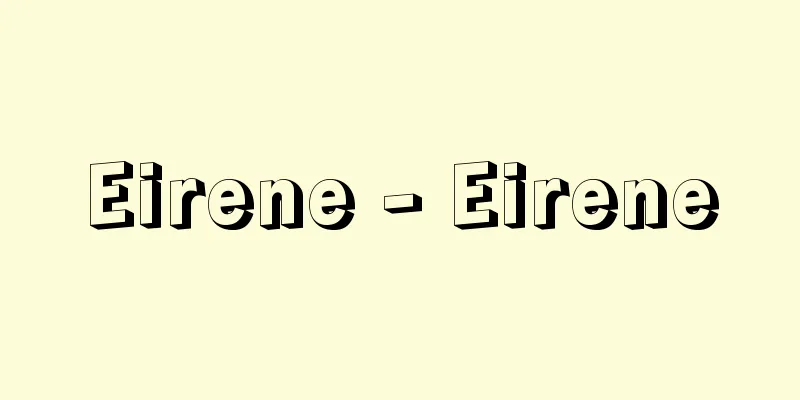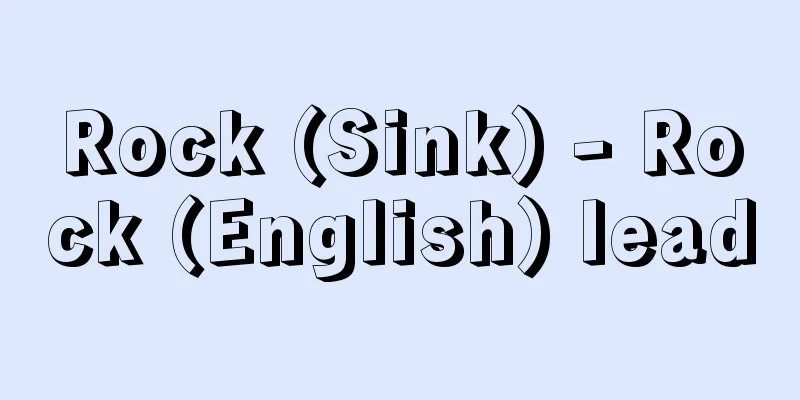Chromosome - chromosome

|
A self-replicating corpuscle made up mainly of deoxyribonucleic acid (DNA) contained within the cells of an organism. The basic structure of chromosomes is the same in all organisms, from lower organisms such as viruses and bacteria to higher animals and plants. In lower prokaryotes, DNA with a double helix structure is contained in the cell in a naked form, but in higher eukaryotes, the chromosomes contain not only DNA but also ribonucleic acid (RNA), basic proteins (histones), acidic proteins, and small amounts of lipids and polysaccharides, forming a complex, long, string-like structure (chromatophores) contained within the cell nucleus. When cell division begins, in prokaryotes that do not have a nucleus, the DNA is divided into two and transferred to the two cells, but in cells that have a nucleus (eukaryotes), the chromatophores shorten and develop into corpuscles that stain well with basic dyes and can be observed under an optical microscope. The number and shape of these corpuscles are constant depending on the type of organism, and they were traditionally called chromosomes (chromosomes in the narrow sense). However, recently, the genetic material (DNA) of prokaryotes is also called chromosomes. Chromosomes in eukaryotic cells during mitosis are so named because they stain well with basic dyes such as hematoxylin and carmine. The chromatid threads of resting nuclei cannot be seen with an optical microscope, but when viewed with an electron microscope they appear as long, thread-like structures about 0.3 micrometers thick. DNA replication occurs during this phase, and chromosomes seen during metaphase always consist of two daughter chromosomes. During anaphase, chromosomes separate into single daughter chromosomes, each of which enters a daughter cell. The size of chromosomes during metaphase varies slightly depending on the type of organism, but in human cells, for example, the thickness (diameter) of chromosomes is about 1 to 2 micrometers, and the length is several to several tens of micrometers. The number and shape of chromosomes are constant depending on the type of organism, and are important characteristics of the species. The shape of chromosomes is consistent across different types of organisms, and is called the karyotype. Somatic cells are made up of two pairs of identical chromosomes (homologous chromosomes). One pair is derived from the mother (female parent) and the other from the father (male parent). In general, the number of chromosomes in somatic cells is 2n, and that in reproductive cells is represented by n. Taking humans as an example, somatic cells have 46 chromosomes (2n), of which 23 (n) are derived from the egg and the other 23 (n) are derived from the sperm. Of the 23 pairs, one unequal pair is a sex chromosome involved in sex determination, with the larger one represented by X and the smaller one by Y. The 22 pairs of chromosomes other than the sex chromosomes are called autosomes, and are classified into seven groups, A to G, based on their size and shape. Using conventional staining methods, it was difficult to identify individual chromosome pairs within each group, but a recently developed band staining method has made it possible to identify all chromosome pairs. A chromosome map is a diagram that shows the relative distance between genes on a chromosome. If any two genes that are inherited in a linked manner are arranged in a straight line from the recombination value, a map showing the relative distance between the genes is drawn. This is called a linkage chromosome map. There are cytological chromosome maps that match the positions of genes with chromosomal abnormalities such as chromosomal translocations, duplications, and deletions, and that match chromosomes with genes by creating hybrid somatic cells between different species and determining the relationship between chromosomes and genes through chromosomal elimination and segregation in the hybrid cells. Recently, a detailed cytological chromosome map of humans has been created from human-mouse hybrid cells. A map that links the horizontal stripe pattern of salivary gland chromosomes (salivary gland chromosomes) of dipterans with the positions of genes is called a salivary gland chromosome map. Abnormalities such as chromosomal inversions and translocations may always be present at a certain rate in the natural population of a certain species. This is called chromosomal polymorphism. Also, the same species may show different karyotypes depending on the region in which they live, which is called geographic variation. All of these are factors that cause the differentiation and evolution of species. Chromosomes were first observed by Naegeli in 1842, and were subsequently confirmed by Strasburger in 1875, W. Fleming and others in 1880. The name chromosome was coined by Waldeyere in 1888, derived from the Greek words chroma (color) and soma (body). Ishikawa Chiyomatsu translated it as chromosome in 1892 (Meiji 25). [Toshihide Yoshida] [Reference] | |Source: Shogakukan Encyclopedia Nipponica About Encyclopedia Nipponica Information | Legend |
|
生物の細胞内に含まれるデオキシリボ核酸(DNA)を主成分とした自己増殖性のある小体。染色体の基本構造は、ウイルスやバクテリアなどのような下等生物から高等動植物に至るあらゆる生物を通じ同じである。下等な原核生物では二重螺旋(らせん)構造をしたDNAが裸の形で細胞内に含まれているが、高等な真核生物の染色体はDNAのほかにリボ核酸(RNA)、塩基性タンパク質(ヒストン)、酸性タンパク質および少量の脂質や多糖類が加わり、複雑な長い紐(ひも)状構造(染色糸)となって細胞核内に含まれている。細胞分裂が始まると、核をもたない原核生物ではDNAがそのまま二分して2細胞に移行するが、核をもつ細胞(真核生物)では染色糸は短縮して塩基性色素によく染まり、光学顕微鏡で観察可能な小体に発達する。この小体の数と形は生物の種類により一定で、従来これを染色体とよんだ(狭義の染色体)。しかし、最近では原核生物の遺伝物質(DNA)も染色体とよんでいる。真核細胞における分裂期の染色体は、ヘマトキシリンやカーミンなど塩基性色素によく染まるのでその名がある。休止核の染色糸は光学顕微鏡では判別できないが、電子顕微鏡でみると太さ約0.3マイクロメートルの細長い糸状構造として観察される。この時期にDNAの複製がおこり、分裂中期にみられる染色体はつねに2本の娘(じょう)染色体からなっている。分裂後期では染色体は1本ずつの娘染色体に分かれ、それぞれ娘細胞に入る。 分裂中期の染色体の大きさは生物の種類によって多少違うが、ヒトの細胞を例にとると、染色体の太さ(直径)は約1~2マイクロメートル、長さは数マイクロメートルから十数マイクロメートルである。染色体の数と形は、生物の種類により一定で、生物種の重要な特徴となっている。 染色体の形は生物の種類により一定しており、それを核型という。体細胞は形の等しい2組の染色体(相同染色体)から成り立っている。1組は母方(雌親)から、他方は父方(雄親)から由来したものである。一般に体細胞の染色体数は2nで、生殖細胞のそれはnで表される。ヒトを例にとって染色体の構成を調べてみると、体細胞の染色体(2n)は46個で、そのうち23個(n)は卵子から、ほかの23個(n)は精子由来である。23対のうち不等の1対は性決定に関与する性染色体で、大きいほうをX、小さいほうをYで表す。性染色体以外の22対の染色体を常染色体とよび、これらは大きさと形によりAからGの7群に分類されている。従来の染色法では各群内の個々の染色体対(つい)の識別は困難であったが、最近、発展したバンド染色法ですべての染色体対の識別が可能となった。 染色体上の遺伝子を相対的距離によって配列し、図式によって表したものを染色体地図という。互いに連関して遺伝する任意の二つの遺伝子を組換え価から直線上に配列してみると、遺伝子間の相対的な距離を示す地図が描かれる。これを連鎖染色体地図とよぶ。染色体地図には染色体の転座、重複、欠失などの染色体異常と遺伝子の位置を対応させたり、異種間の雑種体細胞をつくって雑種細胞における染色体の脱落分離から染色体と遺伝子を対応させる細胞学的染色体地図がある。最近、ヒトとマウスの雑種細胞からヒトの詳細な細胞学的染色体地図がつくられている。双翅(そうし)類の唾液腺(だえきせん)染色体(唾腺染色体)の横縞(よこじま)模様と遺伝子の位置を結び付けたものを唾腺染色体地図とよぶ。 染色体の逆位や転座などの異常が、ある生物種の自然集団中につねにある割合で含まれていることがある。これを染色体多型という。また、同一種でありながら生息する地域で異なった核型を示すこともあり、これを地理的変異という。これらはいずれも生物種の分化や進化の要因となっている。 染色体を最初に観察したのは1842年ネーゲリであり、その後1875年にストラスブルガーStrasburger、1880年にW・フレミングなどによって確かめられた。染色体chromosomeという名称は、1888年ワルダイヤーWaldeyereによるもので、ギリシア語のchroma(色)とsoma(体)から名づけられた。それを染色体と訳したのは1892年(明治25)石川千代松である。 [吉田俊秀] [参照項目] | |出典 小学館 日本大百科全書(ニッポニカ)日本大百科全書(ニッポニカ)について 情報 | 凡例 |
>>: Dyeing industry - dyeing industry
Recommend
Toyosaka [town] - Toyosaka
A former town in Kamo District, central Hiroshima ...
Swimming
It means to move freely on the surface, underwate...
Blue Goldfish
…Its shape is almost the same as that of the Dutc...
South
[1] 〘Noun〙① The name of a direction. The direction...
Wairakite (English spelling)
Also known as Wairake zeolite. Ca-type analcime. C...
Oizumiso - Oizuminosho
A manor in Tagawa County, Dewa Province. It is bel...
King
〘Noun〙① A type of karuta gambling. It is played us...
Mnestra
...The glowing sea slug Plocamophers telsii also ...
Prophets
It refers to the literature of the prophets. It i...
Kubokawa [town] - Kubokawa
An old town in Takaoka County, occupying the mount...
Remainder theorem
If the remainder when a polynomial P ( x ) in x is...
Pestle Dance - Kinefuriodori
…There is a habitat for the Japanese laurel tree ...
Prince Manda
Year of death: April 21, 7th year of Tencho (May 1...
Freshwater sponge (freshwater sponge)
A general term for the species of marine sponges b...
Shioya-shi
A medieval samurai family in Izumo. A branch of th...









